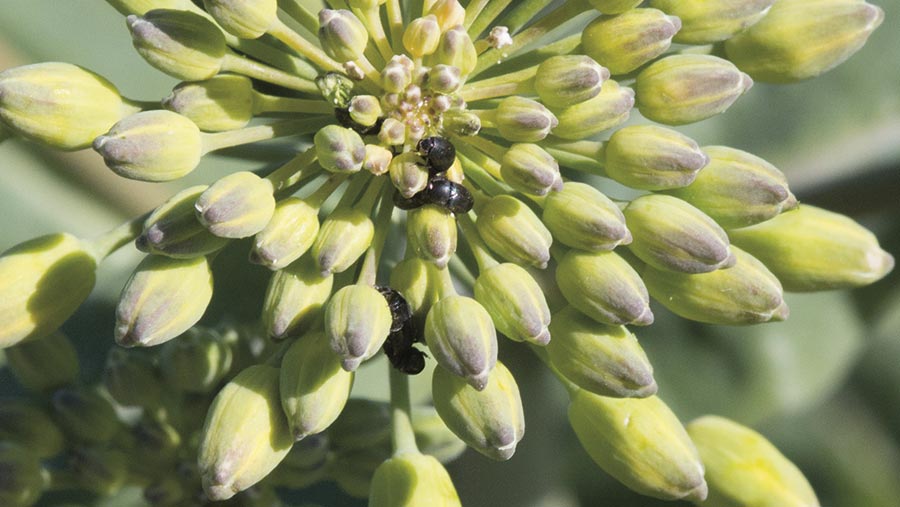Growers urged to avoid unnecessary pollen beetle spraying
 © Tim Scrivener
© Tim Scrivener Oilseed rape growers are being advised to hold their nerve and not rush in with a spray to control pollen beetle, as the pest begins to show up in crops across the UK.
Pollen beetle migration into rapeseed crops is an annual threat from mid-March to late April, with buds being damaged if flowers aren’t yet open.
Eggs are also laid inside the closed bud and the hatching larvae will feed on the bud and flowers in May, limiting the number of pods formed and potentially holding yields back.
But with pest resistance to pyrethroid insecticides now widespread, growers shouldn’t rush in with a spray as soon as pollen beetles are spotted in crops.
See also: How companion crops can raise yields and cut inputs by 30%
Cambridgeshire-based Hutchinsons agronomist Andrew Cromie says an insecticide should only be deployed as a last resort this season.
He said: “The presence of pollen beetles in a crop isn’t necessarily a bad thing. Pollen beetles rarely cause major problems and in many cases it’s worth trying to avoid treating wherever possible.”
Strong plants in thinner crops tend to be more resilient to beetle attack and they tend to branch out more and produce more shoots and flowers, which will compensate for damaged buds.
“With the majority of oilseed rape looking pretty well this spring and advanced crops already approaching flowering, I don’t see a need to spray for pollen beetle in most cases,” Mr Cromie says.
AHDB pollen beetle treatment thresholds for oilseed rape
| Plant population (plants/sq m) |
Treatment threshold (pollen beetles/plant) |
| Less than 30 | 25 |
| 30-49 | 18 |
| 50-70 | 11 |
| More than 70 | 7 |
Beetles on the move
Pollen beetle migration has now begun in all areas of the UK, according to the prediction model run by Bayer, with crops in East Anglia bearing the brunt of activity at present. The pest needs sustained temperatures of 10-15C to break hibernation.
Crops in the South East are nearing the 25% pest migration milestone, while progress in parts of the Midlands and northern England sit at between 15-20%.
See also: Video – How to properly set up a crop sprayer
Activity in the south west of England and in Scotland has only just kicked off, with percentage migration currently in single figures.
The pest is being seen in crops throughout the country now, although most experts are reporting that thresholds aren’t yet hit and a treatment will be unlikely.
Plenty of pollen beetle have arrived near Winchester, and they are in Kent too. pic.twitter.com/Hh8HZWgmcX
— Catherine (@AgriCatherine) March 15, 2017
Spot the pollen beetle! Below threshold for spraying @ProCamUK #agronomythatdelivers pic.twitter.com/y5dtjvjSfA
— Mike Thornton (@treacledinosaur) March 15, 2017
Pollen beetle in #OSR today in Norfolk #thresholds pic.twitter.com/HjSJwgW0pT
— Peter Waite (@pa_waite) March 15, 2017
#pollenbeetle activity low inSouth West, never normally spray and won't be this year#thresholds @SyngentaCropsUK @Bayer4CropsUK @BASFcropUK pic.twitter.com/BfyOGxTRz2
— Richard Alcock (@RichardAlcock68) March 15, 2017
Ground temp today steady now at around 10deg trial site is really flying as too are the pollen beetle no need to spray though . pic.twitter.com/oxxDqA1dth
— Martin Smart (@MartinSmart2) March 15, 2017

